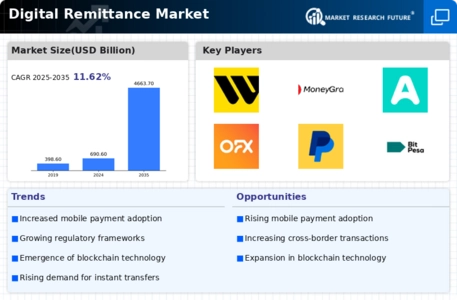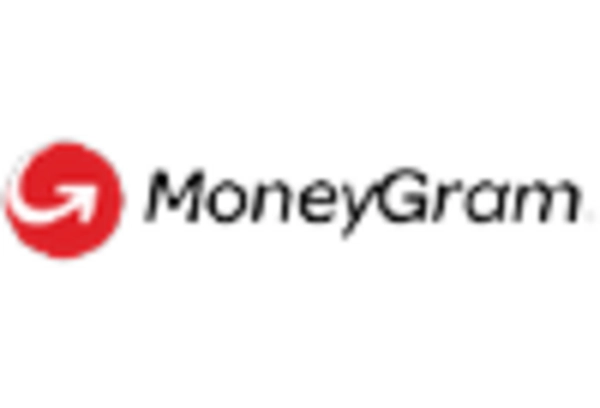The Digital Remittance Market is currently characterized by a dynamic competitive landscape, driven by technological advancements and evolving consumer preferences. Key players such as Western Union (US), PayPal (US), and Remitly (US) are strategically positioning themselves to capitalize on the growing demand for seamless cross-border transactions. Western Union (US) has focused on enhancing its digital offerings, aiming to integrate more advanced technologies into its services. Meanwhile, PayPal (US) continues to expand its global footprint through strategic partnerships, enhancing its service portfolio to cater to diverse customer needs. Remitly (US), on the other hand, emphasizes customer experience and operational efficiency, leveraging data analytics to optimize its service delivery. Collectively, these strategies contribute to a competitive environment that is increasingly centered around innovation and customer-centric solutions.
In terms of business tactics, companies are increasingly localizing their services to better meet regional demands, which appears to be a critical factor in their operational success. The market structure is moderately fragmented, with several players vying for market share, yet the influence of major companies remains substantial. This competitive structure allows for a variety of service offerings, catering to different customer segments and preferences, while also fostering an environment ripe for innovation.
In August 2025, Western Union (US) announced a partnership with a leading fintech firm to enhance its digital payment solutions. This strategic move is likely to bolster its competitive edge by integrating cutting-edge technology into its existing framework, thereby improving transaction speed and security. Such partnerships may also facilitate access to new customer segments, further solidifying Western Union's position in the market.
In September 2025, PayPal (US) launched a new feature aimed at streamlining international money transfers, which allows users to send funds in multiple currencies with minimal fees. This initiative underscores PayPal's commitment to enhancing user experience and could potentially attract a broader customer base, particularly among younger, tech-savvy consumers who prioritize convenience and cost-effectiveness in their financial transactions.
In July 2025, Remitly (US) expanded its services to include cryptocurrency transactions, allowing users to send digital currencies across borders. This strategic pivot not only reflects the growing acceptance of cryptocurrencies but also positions Remitly as a forward-thinking player in the remittance space. By embracing this trend, Remitly may appeal to a niche market of users interested in alternative financial solutions, thereby differentiating itself from traditional remittance services.
As of October 2025, the Digital Remittance Market is witnessing a shift towards digitalization, with companies increasingly integrating artificial intelligence and machine learning into their operations. This trend is indicative of a broader movement towards enhancing operational efficiency and customer engagement. Strategic alliances are becoming more prevalent, as companies recognize the value of collaboration in navigating the complexities of the global remittance landscape. Looking ahead, competitive differentiation is likely to evolve, with a pronounced shift from price-based competition to a focus on innovation, technology integration, and supply chain reliability. This evolution suggests that companies that prioritize these aspects will be better positioned to thrive in an increasingly competitive market.


















Leave a Comment